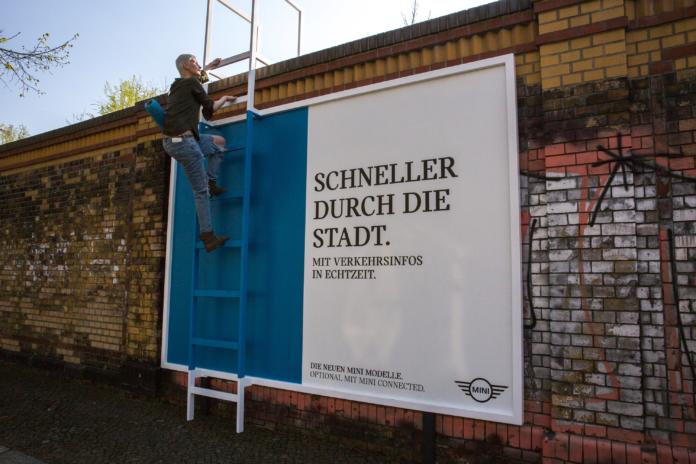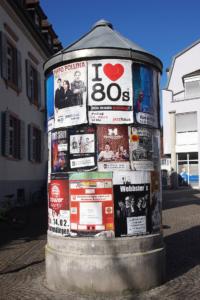Our day-to-day lives expose us to advertising constantly. This is why posters are so successful and their impact can be maximised with some clever planning – also with small marketing budgets.
Up-to-date poster advertising: With its “Schneller durch die Stadt” (Faster through the city) campaign, the agency Serviceplan won the Plakadiva 2019 award for the best innovative use.
On television and radio you can change channels, on the internet you can close ads that pop up and turn over the page in a magazine if you don’t want to be bothered by advertising. Outdoors, it is more difficult to take your eyes off that poster hanging right behind the traffic light that you are waiting at. This is precisely the strength of traditional poster advertising. Mobility is key in our day-to-day lives. We are all out and about a lot of the time – and this makes us receptive to posters in public spaces. They cannot be clicked away and can even be a welcome distraction when you are waiting at the bus stop or are stuck in a traffic jam.
Poster advertising is eye-catching – whether you like it or not
The goal and the principle have not changed for centuries. Poster advertising has an effect where many people see it. It often utilises the element of surprise. The more surprising a large-format ad is, the more intensely passers-by will perceive and remember it. Even the good old advertising column is not outdated yet and new presentation media are available today.
Contents
Outdoor poster advertising
Since Ernst Litfaß installed his first column in Berlin in 1855, the range of poster advertising has expanded considerably. Posters come in various shapes and sizes. Here is an overview of the different options:
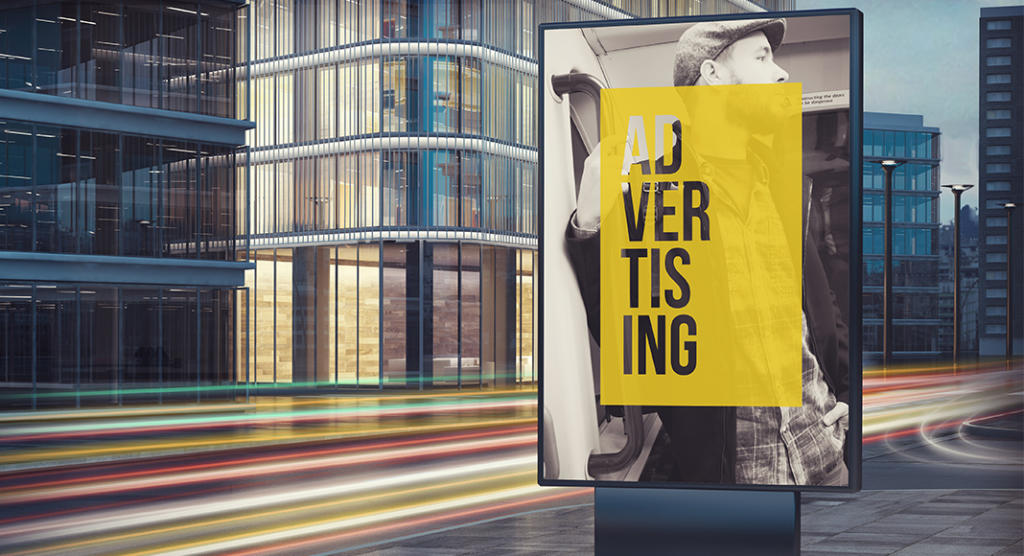
Large format (9 sqm)
These XXL posters are around nine square metres in size and are one of the most widespread advertising mediums in the out-of-home sector according to the Outdoor Advertising Association (Fachverband Außenwerbung, FAW). Around 152,000 are available in Germany. The advantage of this type of advertising is that only a few selected locations can be booked. The poster can optionally be illuminated.
Extra large format (18 sqm)
The posters are twice the size of the large format. They are always illuminated and only found in cities with more than 100,000 inhabitants.
Super poster
3.72 metres high and 5.26 metres wide, super posters are slightly larger than the extra large format and have been hanging on building walls in prominent positions since 1978. Today, they are all illuminated and can be booked in 110 German cities.
Giant posters
A giant poster is as large as specified by clients. These area-wide posters often cover entire building fronts and are installed in cooperation with location scouts.
Advertising pylons
Between 35 and 60 metres high, the pylons are set up nearby motorways, provide an advertising area of up to 224 square metres and are visible from far away.
City Lights
Illuminated and installed behind glass, this type of poster is available in three different formats:
- City Light Poster: These outdoor posters sized 119 x 175 cm are located in city centres, train stations, airports and shopping centres. Combined with additional technology, City Light posters are increasingly integrated into complex advertising worlds.
- City Light Board: These large format billboards at a height of around 2.50 metres are mainly positioned on heavy traffic locations and often show changing displays.
- City Light Column: The shape is similar to the traditional advertising column; the presentation is behind glass and illuminated, accommodating up to six City Light posters.
Advertising column
Also known as Morris column or Litfass column, this traditional form of advertising has been used in public spaces for more than 160 years. They come in a variety of styles, from modern to nostalgic. In advertising jargon they are distinguished by the type of occupancy:
- Collective use: This type of advertising column has retained its original character. It is used collectively by multiple companies or event organisers that advertise their products or services. The costs are relatively low and can also be afforded by small businesses.
- Exclusive use: This form of advertising is much more expensive because – as the name suggests – the advertiser has the entire space for itself.
Poster advertising for small budgets
Smaller companies that generally don’t have the budget to book large advertising spaces can still benefit from this effective form of advertising. Successful advertising at manageable costs merely requires some careful planning:
- Defining the goal: What do you want to achieve? Do you advertise the company in general or a specific event or limited promotion?
- Target group: Which consumers or users do I target with my posters?
- Finding a location: Place your ad where your target group will see it. Often it makes sense to advertise near your place of business, especially if you want to encourage customers to drop by. If athletes are your target audience, choose advertising spaces near gyms, sports fields or on popular running routes.
- Low-priced alternatives: As mentioned above, collective use sites offer good value for money for posting advertising messages. Some municipalities also provide public billboards. Or maybe you find other attractive spots for your advertising – provided it is legal to put up posters there. You should also consider indoor advertising, such as bulletin boards, display cases and wall spaces in buildings frequented by your target group.
Where can I put up posters?
You cannot put up a poster anywhere you like. Explicit advertising spaces must be booked with the operator; a permit is needed for public property. The regulation is a matter of the federal states and is handled differently by individual municipalities. You also have to ask for permission before putting up posters on private fences and walls. Contact the building authority, the regulatory agency of your town or the local government.
Poster advertising: how often and for how long?
Even good advertising only makes a lasting impression if recipients are exposed to it repeatedly. Therefore, advertising spaces can usually be booked for a week or ten days. This is also the time that is required to generate multiple contacts with the target audience.
Consequently, a poster should hang for at least one week to generate the recognition you are aiming for. To make sure the poster is noticed multiple times, it should be placed in a high-traffic location. Or it is installed in multiple locations which are frequented by at least parts of your target audience.
Creating attention with poster advertising
Designing a successful poster takes some time. Though it isn’t rocket science even for beginners, there are a few things to consider to create a high-impact advertising poster.
Design tips for posters and more
Whether you are announcing an event or launching a sophisticated marketing campaign: The more eye-catching a poster, the more likely it is to be noticed. To stand out from the crowd, there are several approaches to designing a poster:
- Size: A poster that covers an entire building facade is hard to miss. Large-format advertising is still eye-catching in smaller sizes. Unfortunately, this type of advertising is very expensive.
- Rich colours: Adding colour to your poster will enhance perception and awareness. However, too much can be counter-productive under certain circumstances – e.g. if a subject appears too disharmonious or distracts too much from the advertising message.
- High contrast: Colours that stand out from each other are particularly attention-grabbing. However, this may be at the cost of design harmony.
- Plain colours: Use a single colour! If, for example, a poster is completely green, it will stand out from its multi-coloured neighbours. Choosing the colour nuances and creating the necessary contrast requires some design skills though. Moreover, the colour should match the subject of the advertising message or the corporate identity.
- Empty space: Empty spaces always look generous because there is no need to use the entire area for your advertising. At the same time, you will stand out from the majority of other posters which cover the entire space available. Leaving the empty space white or black adds a touch of elegance. However, the latter can also have a slightly depressing touch.
- The black-and-white poster by Steiner Grafik is really eye-catching.
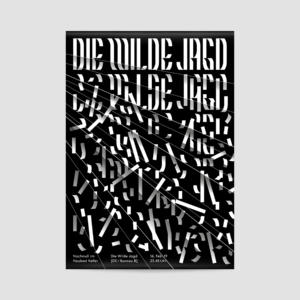
The black-and-white poster by Steiner Grafik is really eye-catching. Optical tricks: The spiral illusion or a widening spiral staircase – optical illusions are attention-grabbing and beg the viewer to take another look. The poster by Steiner is a good example of this; it advertises a theatre event (see picture) and utilises a simple yet powerful black-and-white design. Viewers are baffled by the letters that appear to be tumbling around after the second row.
- Unexpected images: We stop short at the sight of a monkey with a green fur or an orange with a fried egg inside instead of pulp. And then we will probably take a closer look. When we encounter the image again, we will also be inspired to look again.
- Added value: Admittedly, this is a tough one. After all, you cannot put the latest traffic jam report or weather forecast on printed posters. But you can include different kinds of information. They should be short and to the point to prevent the poster from being overloaded.
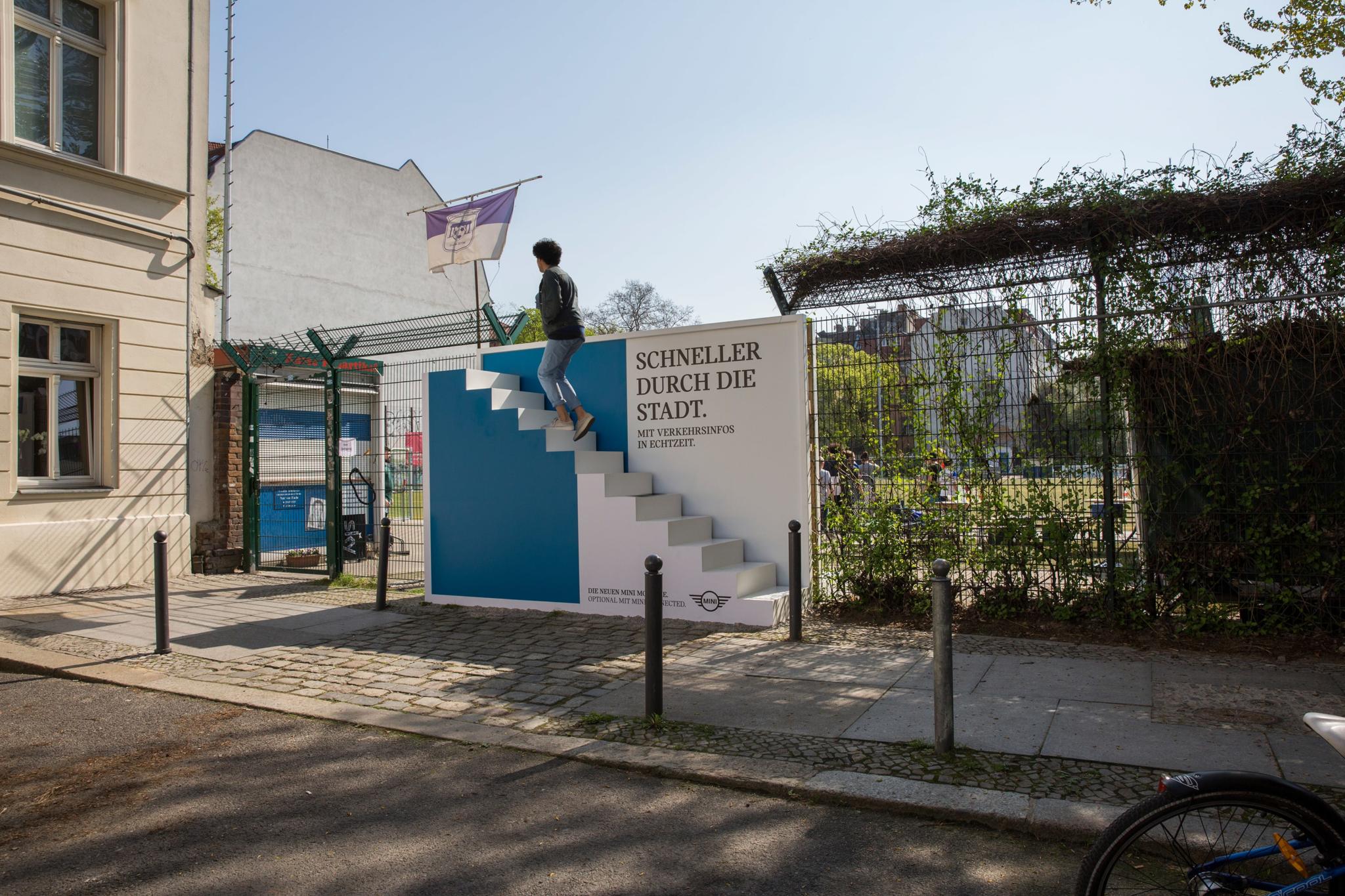
Funny: The Munich-based agency Serviceplan came up with a particularly clever outdoor advertising campaign for BMW Mini. It designed posters that present shortcuts in Berlin and implemented some constructional modifications to enable people to use these shortcuts, such as a staircase or ladder to get over walls and fences.
Communicating the advertising message
Content is key as we all know now. But it has to be presented in such a way that it reaches the addressees. Below we have summarized the key points:
1. Keep it short, sweet and simple
“Keep it short and sweet!” A poster must show at first glance what it is about. This can be achieved through the subject alone or by accompanying text which ideally should not exceed five words. If you want to add information, e.g. when advertising an event, the text should be divided into several groups, however, not more than five.
2. Unity of image and text
If the message of the poster becomes clear only through the combination of subject and words, the image and the text must create a visual unit. The text can be positioned near or inside the image in this case.
3. Legibility
The text should also be readable from a distance. If you have to guess for too long, you won’t be too receptive for the advertising message. Consequently, the font type and font size should be chosen carefully. For inspiration and suggestions of suitable fonts, read the article Head-turning poster fonts.
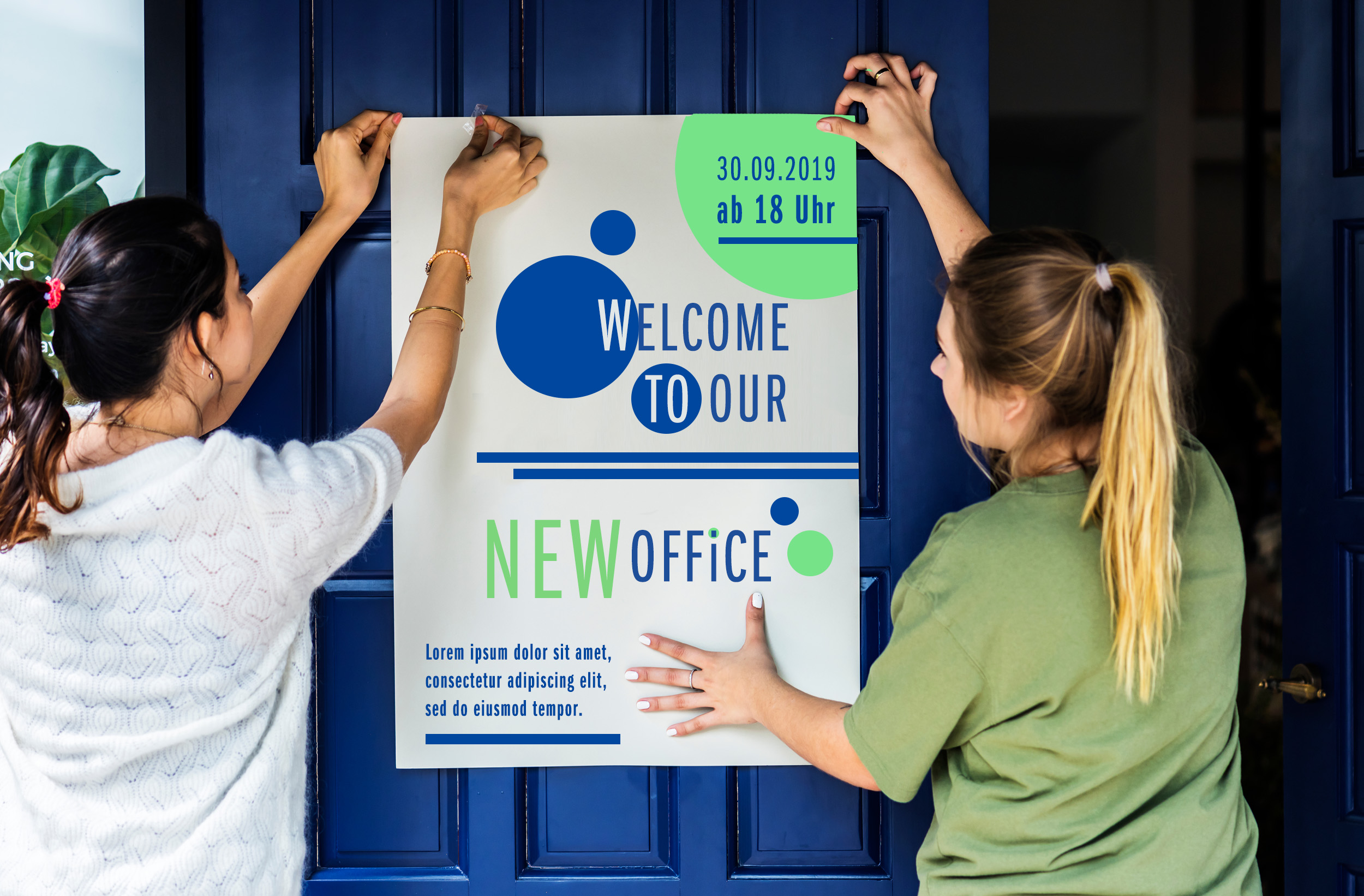 4. Suitable design
4. Suitable design
The text, subject and colour scheme must all match the advertising message and the company. For example, an attractive woman wearing a cocktail dress would be out of place in an ad for agricultural machinery. But since unusual or provocative designs can attract attention, it should be weighed up in advance how far the agency or graphic designer can go.
5. Identify the sender
So the whole city is crazy about your offer but they don’t know where to get it. This may sound trivial, but is forgotten more often than you think. People who are interested in the advertised product must be able to see at a glance which company sells it and where they can get it. If you advertise and event or limited offer, the date must also be prominent.
6. Unambiguous messages
Ambiguous advertising messages may not be well received by both passers-by and competitors. To be on the safe side, take a look at the Act against Unfair Competition.
Beware of pitfalls
Provoking is a sure way to get attention. In some cases, however, this can have negative consequences. Because it is so difficult to avoid advertising in public spaces, billboard advertisers have to pay attention to a number of things that can be summarised with two keywords: endangerment and discrimination.
Protection of minors in public
The first aspect primarily concerns the protection of minors. Everything that could endanger children and young people should not be advertised in public. Germany is the only EU country where tobacco advertising on posters has not been banned yet but the majority of Germans are calling for such a ban. Accordingly, people are generally sensitive to advertising in public that is harmful to minors.
Weighing up boundaries and avoiding discrimination
The issue of discrimination is even more complex. It is often not easy to decide whether something is discriminating or not. This major pitfall can be avoided by not targeting minorities, migrants, regions (also in your country) and religious groups. You should also avoid sexist content, clichés and stereotyping. Try to imagine the planned advertisement with a man instead of a woman and see whether this has sexist connotations. To be on the save side, ask women for their opinion before printing the posters.
Beware of shitstorms! If you (unknowingly) insult passersby or hurt their feelings, you risk a shitstorm. If someone files a complaint with the German Advertising Standards Council the latter may also issue a public reprimand. Moreover, Werbemelder.in is a German website where you can report advertising that discriminates women. Discriminating ads can also be reported to social media platforms.
Poster printing
It was a long time ago when posters were made of paper only. Today, various materials are available which are much more resistant to outdoor weathering. Some are available at Onlineprinters also in small quantities. Here is a small selection:
Weather-proof posters
- Corrugated sheets (available in large quantities)
- Posters made of polyester film (available in small quantities)
- Fabric posters
- City Light posters
- Posters made of polyester (available in small quantities)
- Posters for showcases (made of backlit film; available in small quantities)
Poster advertising made of robust papers
- Posters made of blue back paper (also available in small quantities)
- Weather-proof posters
Poster advertising is, and will remain, effective
No matter which format you choose, traditional poster advertising is far from outdated and still has its place in the digital age. Well-placed and targeted poster advertising is also a good way to reach target audiences that enjoy non-digital activities, such as children and senior citizens.
Sources: Outdoor Advertising Association (Fachverband Außenwerbung, FAW), Federal Ministry of Justice and Consumer Protection
Photo credits: Serviceplan Group (i.a. Title photo), Steiner Grafik; Gina_Janosch, jplenio, QuinceMedia, geralt via Pixabay; Georgejmclittle, Rawpixel.com, TypoArt BS via Shutterstock
